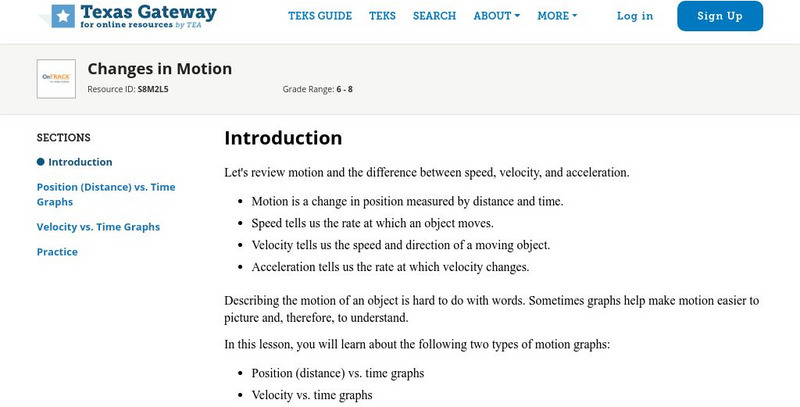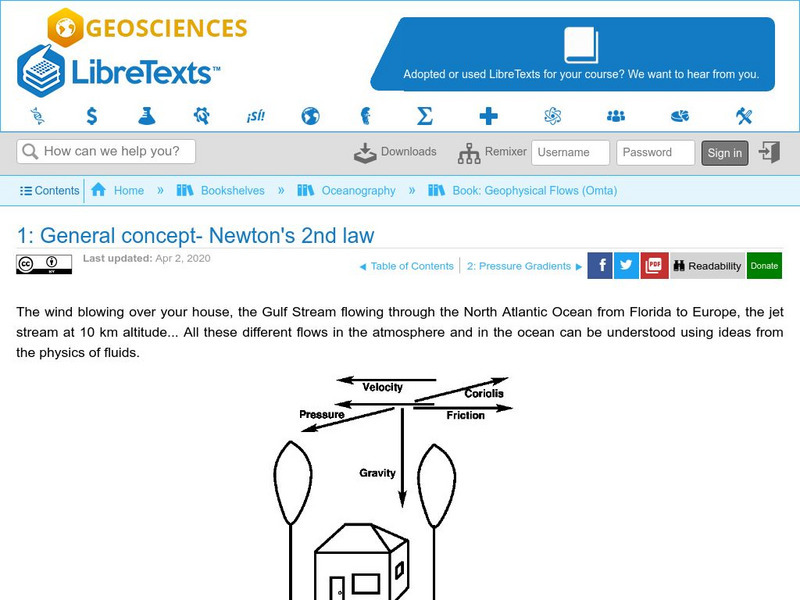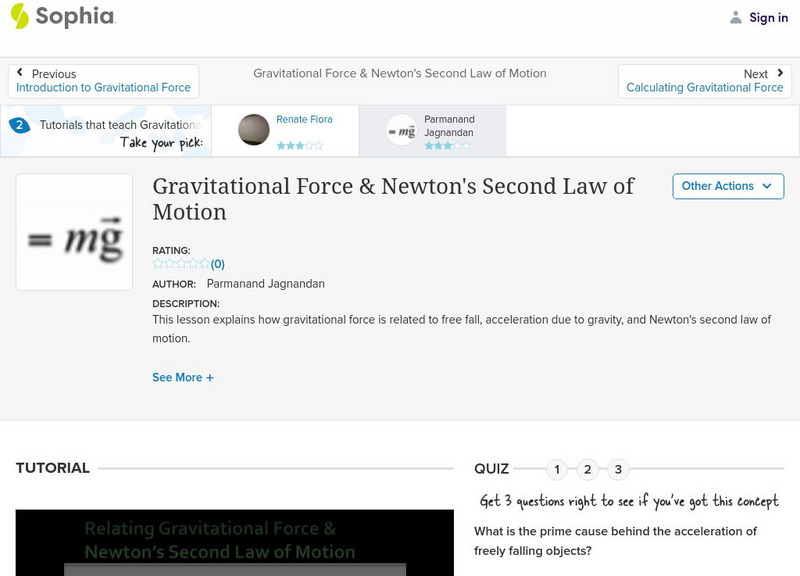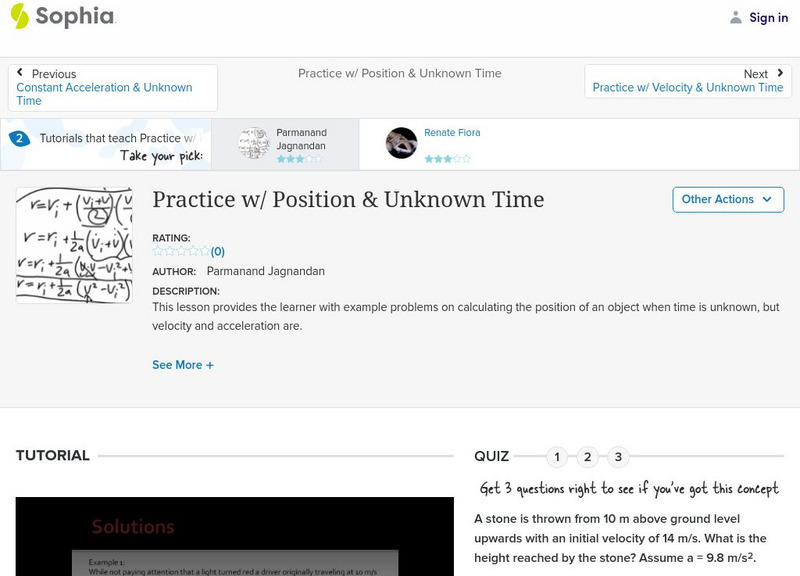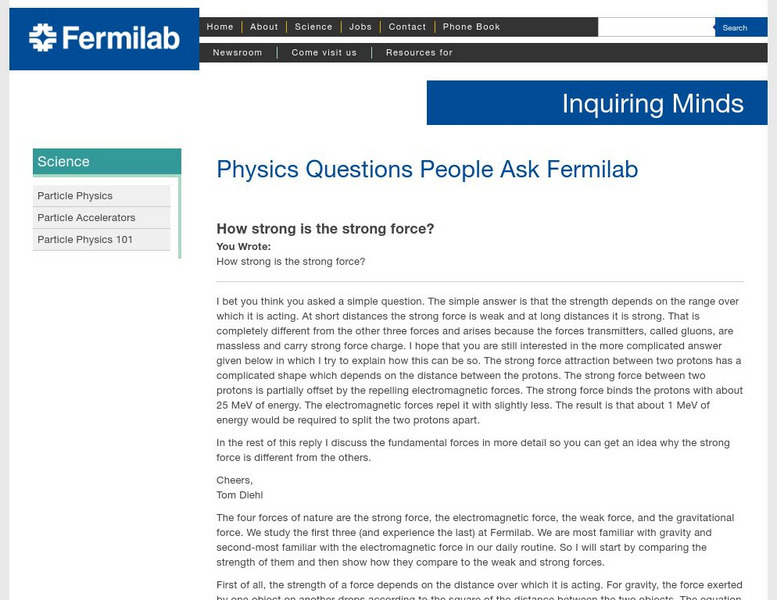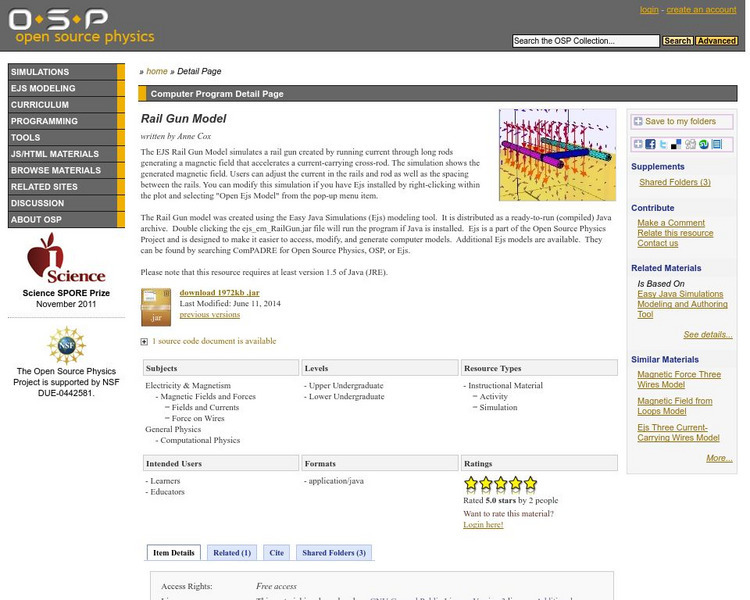Hi, what do you want to do?
Texas Education Agency
Texas Gateway: Changes in Motion
In this lesson, you will learn about position vs. time graphs and velocity vs. time graphs and how to use them to solve problems.
Physics Classroom
The Physics Classroom: Kinetic Energy
Kinetic energy is defined and explained--learning exercises are included to assess your understanding.
Libre Text
Uc Davis Geo Wiki: Newton's 2nd Law
The wind blowing over your house, the Gulf Stream flowing into the North Atlantic Ocean from Florida to Europe, the jet stream at 10 km altitude. All these different flows in the atmosphere and in the ocean can be understood using ideas...
Physics Classroom
The Physics Classroom: Horizontal and Vertical Components of Velocity
Students learn how to describe the motion of projectiles numerically; specifically how the numerical values of the x and y components of the velocity and displacement change with time. Includes animations and interactive simulation.
Physics Aviary
Physics Aviary: Force Direction Relative to Motion
This lab/learning activity is designed to introduce students to the idea of how direction of force relative to motion determines the future motion of the object subjected to the force. Students can also explore the factors that determine...
Physics Classroom
The Physics Classroom: 1 D Kinematics: Determining the Area on a v T Graph
In this interactive physics tutorial, students learn how a plot of velocity versus time can also be used to determine the displacement of an object.
Other
Particle Physics at Discovery's Horizon: What Is the Lhc?
An introduction to the Large Hadron Collider (LHC), offering information on its location, its experiments, and what scientists hope to learn through this machine buried below Geneva, Switzerland. Click a menu of links to read details...
Cosmo Learning
Cosmo Learning: Physics 240: Science and Engineering I
A collection of video lectures from a physics for science and engineering course taught at the University of Missouri-Kansas City. The course discusses the concepts of mechanics, wave motion, sound, heat and thermodynamics in thirty-five...
Learn AP Physics
Learn Ap Physics: Physics B: Kinematics
A site dedicated to help students prepare for the AP Physics B test. This specific site reviews kinematics including one and two dimensional motion and vectors. Site contains links to video lectures and practice problems.
Alabama Learning Exchange
Alex: Newton's Laws of Motion
Middle schoolers use toy cars, a CBR sonic motion detector, and pennies to investigate Newton's Laws of Motion.
Lawrence Berkeley National Laboratory
Berkeley Lab: Linear
Use this site to learn about the invention of the linear accelerator and how it works.
Other
Pc Guide: Video Cards
This site from the PC Guide provides a detailed explanation of what a video card is and its purpose. This site is a thorough reference to learn more about video cards and their capabilities.
Sophia Learning
Sophia: Gravitational Force & Newton's Second Law of Motion
This lesson explains how gravitational force is related to free fall, acceleration due to gravity, and Newton's second law of motion.
Sophia Learning
Sophia: Practice W/ Position & Unknown Time: Lesson 1
This lesson provides the learner with example problems on calculating the position of an object when time is unknown, but velocity and acceleration are. It is 1 of 2 in the series titled "Practice w/ Position & Unknown Time."
Other
Fermi Laboratory:how Strong Is the Strong Force?
Use this site to learn about the four forces of nature. Also learn what determines the strength of a force. This question and answer site is a link of the Fermi National Accelerator Laboratory.
Lawrence Berkeley National Laboratory
Berkeley Lab: Cyclotron
Learn about the cyclotron, a particle accelerator invented in 1929 by Ernest O. Lawrence.
Ducksters
Ducksters: Physics for Kids: Force
Kids learn about force in the science of physics and the laws of motion including units and measurement. How to calculate force from mass and acceleration.
Upper Canada District School Board
Tom Stretton's Chemistry Pages: Dynamics Bodies in Motion
Through an online slide-show format, learn about the physics of motion, including Newton's laws of motion.
Middle School Science
Middle School Science: Motion Crossword Puzzle
Let your students have a little fun and reinforce their learning of motion-related concepts at the same time.
Other
Best Evidence Encyclopedia: Middle and High School Reading
Looking for opportunities to improve your readers or to help your readers get ahead? BEE presents a number of programs that have been evaluated by their researchers to bring educators the best programs on the market. Learn about programs...
White House Historical Association
White House Historical Association: Watergate, Gerald Ford, and the Nixon Pardon
Lesson plan on an incredible chain of events that led to Ford's presidency. Students learn about this tale of American history, beginning with the Watergate break-in, the Saturday Night Massacre, and an accelerating crisis that would...
Other
Australian Acad. Of Science: Food Waste: Preventing Multi Billion Dollar Problem
The top priority when it comes to food waste is to avoid generating more. Food waste includes all food intended for human consumption that never reaches us, as well as edible food that consumers throw away. As it rots in landfills, food...
American Association of Physics Teachers
Com Padre Digital Library: Open Source Physics: Rail Gun Model
Simulate the movement of a rail gun in this interactive model. Learn how a magnetic field is generated by running electrical current through long rods that accelerates a current-carrying cross-rod.
Symmetry Magazine
Symmetry Magazine: Explain It in 60 Seconds: Rare Particle Decays
Rare particle decays, described here, are events that could lead to insights into the unknown processes of the universe. Scientists hope to learn more about them through research with particle accelerators. "Explain It In 60 Seconds" is...





